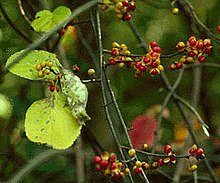Oriental staff vine
| Oriental Bittersweet | |
|---|---|
 |
|
| Celastrus orbiculatus | |
| Scientific classification | |
| Kingdom: | Plantae |
| (unranked): | Angiosperms |
| (unranked): | Eudicots |
| (unranked): | Rosids |
| Order: | Celastrales |
| Family: | Celastraceae |
| Genus: | Celastrus |
| Species: | C. orbiculatus |
| Binomial name | |
|
Celastrus orbiculatus Thunb. |
|
Celastrus orbiculatus is a woody vine of the Celastraceae family. It is commonly called Oriental bittersweet. Other common names include Chinese bittersweet,Asian bittersweet,Round-leaved bittersweet, and Asiatic bittersweet. Celastrus orbiculatus was introduced into North America in 1879, and is considered to be an invasive species in eastern North America. It closely resembles the native North American species, Celastrus scandens, with which it will readily hybridize.
The defining characteristic of the plant is its vines: they are thin, spindly, and have silver to reddish brown bark. They are generally between 1 and 4 cm (0.4 and 1.6 in) in diameter. When Celastrus orbiculatus grows by itself, it forms thickets; when it is near a tree or shrub, the vines twist themselves around the trunk. The encircling vines have been known to strangle the host tree to death, which is also true of the American species, C. scandens. The leaves are round and glossy, 2–12 cm (0.8–4.7 in) long, have toothed margins and grow in alternate patterns along the vines. Small green flowers produce distinctive red seeds which are encased in yellow pods that break open during autumn. All parts of the plant are poisonous.
Due to systematic disturbances to eastern forests for wood production and recreation, Oriental bittersweet has naturalized to landscapes, roadsides, and woodlands of eastern North America. In the United States it can be found as far south as Louisiana, as far north as Maine, and as far west as the Rocky Mountains. It prefers mesic woods, where it has been known to eclipse native plants.
Oriental bittersweet is a strong competitor in its environment, and its dispersal has endangered the survival of several other species. One attribute that contributes to the success of this species is having attractively colored fruit. As a result, it is eaten by mammals and birds, which excrete the seeds to different locations.
The introduction of Oriental bittersweet into new areas threatens the local flora because the native plants then have a strong competitor in the vicinity. The species is native to Eastern Asia, but was introduced to the US for aesthetic purposes. It has been used in floral arrangements, and because of improper disposal the plant has been recklessly introduced into areas, affecting the ecology of over 33 states from Georgia to Wisconsin, and parts of the Appalachians. The organism grows primarily in the perimeter of highly vegetative areas, allowing it to readily access the frontier of resources. Oriental bittersweet’s ability to grow in a variety of environments has proven to be detrimental to many plant species along the Appalachian mountains and is moving more towards the West as time progresses.
...
Wikipedia
